Construction and Application of Ecological Remediation Technology for Sandy Soils in Northwest China
Abstract
:1. Introduction
2. Theoretical Hypothesis
2.1. Regional Overview
2.2. Research Methodology
2.3. Sample Data Collection
2.4. Soil Sample Measurement Methods and Data Processing Methods
3. Results and Analysis
3.1. Analysis of Changes in Regional Vegetation Characteristics under Multiple Scenarios
3.2. Regional Soil Physicochemical Characteristics Analysis under Multiple Scenarios
3.3. Regional Soil Organic Carbon Characterization under Multiple Scenarios
3.4. Regional Soil Nitrogen Characterization under Multiple Scenarios
3.5. Characterization of Regional Soil Enzyme Activity under Multiple Scenarios
4. Discussion
5. Conclusions
Author Contributions
Funding
Institutional Review Board Statement
Informed Consent Statement
Data Availability Statement
Conflicts of Interest
Abbreviations
| Abbreviation | Full Name |
| PRS | A mixture of phyllanthus, ryegrass, and sclerotium |
| OLRS | A mixture of overhanging leaves, ryegrass, and sclerotium |
| NRM | Natural Recovery Mode |
| UMD | Unrestored Mobile Dune |
| SOC | Soil organic carbon |
| SMC | Soil Microbial Carbon |
| MN | Microbial Nitrogen |
| NH4+-N | Ammonia nitrogen |
| NO3−-N | Nitrate nitrogen |
| EOC | Easily Oxidizable Organic Carbon |
| POC | Particulate Organic Carbon |
| MC | Mineralizable Carbon |
| SMN | Soil Mineralizable Nitrogen |
| PRO | Soil protease |
| NR | Nitrate reductase |
| URE | Urease |
| PPO | Polyphenol Oxidase |
| CEL | Cellulase |
| AMY | Amylase |
| SUC | Sucrase |
| SSOC | Soil Soluble Organic Carbon |
References
- Lv, P.; Zhang, J.; Zuo, X.; Wang, S.; Zhou, X.; Zhao, X.; Zhang, T. Plant functional diversity enhances associations of soil fungal diversity with vegetation and soil in the restoration of semiarid sandy grassland. Ecol. Evol. 2016, 6, 318–328. [Google Scholar] [CrossRef]
- Wu, G.L.; Zhang, M.Q.; Liu, Y.; Vicentec, M. Litter cover promotes biocrust decomposition and surface soil functions in sandy ecosystems. Geoderma 2020, 374, 114429. [Google Scholar] [CrossRef]
- Lichao, G.Z.; Chen, M.; Song, Y.; Peolin, G.E.; Minghao, M.O.; Duan, J. Design and Research of Wind Erosion in Sandy Land and Typical Sand Fixation Project in Small Watershed in Jiangxi Province. IOP Conf. Ser. Earth Environ. Sci. 2019, 358, 022048. [Google Scholar] [CrossRef]
- Yan, R.; Feng, W. Effect of vegetation on soil bacteria and their potential functions for ecological restoration in the Hulun Buir Sandy Land, China. Effect of vegetation on soil bacteria and their potential functions for ecological restoration in the Hulun Buir Sandy Land, China. J. Arid Land 2020, 12, 473–494. [Google Scholar] [CrossRef]
- Wu, G.L.; Jia, C.; Huang, Z.; Manuel, L.V.; Yu, L. Plant litter crust appear as a promising measure to combat desertification in sandy land ecosystems: An Interdisciplinary Journal of Soil Science Hydrology-Geomorphology Focusing on Geoecology and Landscape Evolution. Catena 2021, 206, 105573. [Google Scholar] [CrossRef]
- Miao, R.; Jiang, D.; Musa, A.; Zhou, Q.; Wang, Y. Effectiveness of shrub planting and grazing exclusion on degraded sandy grassland restoration in Horqin sandy land in Inner Mongolia. Ecol. Eng. 2015, 74, 164–173. [Google Scholar] [CrossRef]
- Liu, Y.; Havrilla, C.A.; Jia, C.; Liu, X.; Wu, G.L. Litter crusts enhance soil nutrients through bacteria rather than fungi in sandy ecosystems. Catena 2015, 204, 105413. [Google Scholar] [CrossRef]
- Fu, B.; Qi, Y.; Chang, Q. Impacts of revegetation management modes on soil properties and vegetation ecological restoration in degraded sandy grassland in farming-pastoral ecotone. Int. J. Agric. Bioeng. 2015, 8, 26–34. [Google Scholar] [CrossRef]
- Kooijman, A.M.; Cusell, C.; Mourika, J.V.; Reijmana, T. Restoration of former agricultural fields on acid sandy soils: Conversion to heathland, rangeland or forest? Ecol. Eng. 2016, 93, 55–65. [Google Scholar] [CrossRef]
- Yu, X.; Huang, Y.; Li, E.; Li, X.; Guo, W. Effects of vegetation types on soil water dynamics during vegetation restoration in the Mu Us Sandy Land, northwestern China. J. Arid. Land 2017, 9, 188–199. [Google Scholar] [CrossRef]
- Zhao, G.; Wang, H.; Junbao, L.I.; Guo, H. Study on Spatial Variation of Soil Moisture in Coal Mining Subsidence Area in Mu Us Sandy Land. Asian Agric. Res. 2018, 10, 66–70. [Google Scholar] [CrossRef]
- Li, R.; Shi, C.; Yang, J.; Wei, G.; Liu, J.; Kui, G.; Ai, X.; Xiao, F.; Su, R. Site Type Classification and Ecological Restoration Technology Selection of Open-pit Coal Mine Dumps in Grassland Mining Area. J. Resour. Ecol. 2023, 14, 757–766. [Google Scholar] [CrossRef]
- Li, Y.; Wang, Z.; Shi, W.; Yang, H. Litter quality modifies soil organic carbon mineralization in an ecological restoration area. Land Degrad. Dev. 2023, 34, 1806–1819. [Google Scholar] [CrossRef]
- Li, S.; Li, C.; Yao, D.; Wang, S. Feasibility of microbially induced carbonate precipitation and straw checkerboard barriers on desertification control and ecological restoration. Ecol. Eng. 2020, 152, 105883. [Google Scholar] [CrossRef]
- Wang, Y.; Chen, M.; Yan, L.; Yang, G.; Ma, J.; Deng, W. Quantifying threshold water tables for ecological restoration in arid Northwestern China. Groundwater 2020, 58, 132–142. [Google Scholar] [CrossRef]
- Jiang, C.; Zhang, H.; Zhao, L.; Yang, Z.; Wang, X.; Yang, L.; Wen, M.; Geng, S.; Zeng, Q.; Wang, J. Unfolding the effectiveness of ecological restoration programs in combating land degradation: Achievements, causes, and implications. Sci. Total Environ. 2020, 748, 141552. [Google Scholar] [CrossRef]
- Xiu, L.; Yan, C.; Li, X.; Qian, D.; Feng, K. Monitoring the response of vegetation dynamics to ecological engineering in the Mu Us Sandy Land of China from 1982 to 2014. Environ. Monit. Assess. 2018, 190, 543. [Google Scholar] [CrossRef]
- He, J.; Shi, X.; Fu, Y.; Yuan, Y. Evaluation and simulation of the impact of land use change on ecosystem services trade-offs in ecological restoration areas, China. Land Use Policy 2020, 99, 105020. [Google Scholar] [CrossRef]
- Liu, X.; Lai, Q.; Yin, S.; Bao, Y.; Qing, S.; Mei, L.; Bu, L. Exploring sandy vegetation sensitivities to water storage in China’s arid and semi-arid regions. Ecol. Indic. 2022, 136, 108711. [Google Scholar] [CrossRef]
- Schröder, R.; Kiehl, K. Ecological restoration of an urban demolition site through introduction of native forb species. Urban For. Urban Green. 2020, 47, 126509. [Google Scholar] [CrossRef]
- Zhen, L.; Ishwaran, N.; Luo, Q.; Wei, Y.; Zhang, Q. Role and significance of restoration technologies for vulnerable ecosystems in building an ecological civilization in China. Environ. Dev. 2020, 34, 100494. [Google Scholar] [CrossRef]
- Li, Q.; Yang, D.; Jia, Z.; Zhang, L.; Zhao, X. Changes in soil organic carbon and total nitrogen stocks along a chronosequence of Caragana intermedia plantations in alpine sandy land. Ecol. Eng. 2019, 133, 53–59. [Google Scholar] [CrossRef]
- Zhao, H.; Chen, X.; Zhang, Z.; Zhou, Y. Exploring an efficient sandy barren index for rapid mapping of sandy barren land from Landsat TM/OLI images. Int. J. Appl. Earth Obs. Geoinf. 2019, 80, 38–46. [Google Scholar] [CrossRef]
- Jian, Z.; Zhang, F.; Xu, Y.; Gao, Y.; Zhang, B.; Li, C. Analysis of land use/cover pattern and its changes in the agro-pastoral ecotone based on the precipitation and soil types: Acase study of Horqin Left Rear Banner. Geogr. Res. 2017, 36, 1210–1222. [Google Scholar] [CrossRef]
- Junior, C.P.; Pereira, M.G.; Filho, J.; Beutler, S.J. Can topography affect the restoration of soil properties after deforestation in a semiarid ecosystem? J. Arid. Environ. 2018, 162, 45–52. [Google Scholar] [CrossRef]
- Chen, W.; Ge, Z.M.; Fei, B.L.; Zhang, C.; Liu, Q.X.; Zhang, L.Q. Soil carbon and nitrogen storage in recently restored and mature native Scirpus marshes in the Yangtze Estuary, China: Implications for restoration. Ecol. Eng. 2017, 104, 150–157. [Google Scholar] [CrossRef]
- Guo, X.; Hu, Y.; Zhang, Y.; Zhen, L. Using 137Cs and 210Pbex to Investigate the Soil Erosion Moduli of the Sandy Area of Typical Grasslands in Northern China. Sustainability 2022, 14, 12137. [Google Scholar] [CrossRef]
- Jiao, T.; Davy, A.J.; Jiang, D.; Musa, A.; Miao, C. Effects of excluding grazing on the vegetation and soils of degraded sparse-elm grassland in the Horqin Sandy Land, China. Agric. Ecosyst. Environ. 2016, 235, 340–348. [Google Scholar] [CrossRef]
- Pilipović, A.; Zalesny Jr, R.S.; Rogers, E.R.; McMahon, B.G.; Nelson, N.D.; Burken, J.G.; Hallett, R.A.; Lin, C.H. Establishment of regional phytoremediation buffer systems for ecological restoration in the Great Lakes Basin, USA. ii. new clones show exceptional promise. Forests 2021, 12, 474. [Google Scholar] [CrossRef]
- Dai, Y.; Dong, Z.; Li, H.; He, Y.; Li, J.; Guo, J. Effects of checkerboard barriers on the distribution of aeolian sandy soil particles and soil organic carbon. Geomorphology 2019, 338, 79–87. [Google Scholar] [CrossRef]
- Li, Y.F.; Li, Z.W.; Wang, Z.Y.; Tian, S.M. Impacts of artificially planted vegetation on the ecological restoration of movable sand dunes in the Mugetan Desert, northeastern Qinghai-Tibet Plateau. Int. J. Sediment Res. 2017, 32, 277–287. [Google Scholar] [CrossRef]
- Roy, R.; Wang, J.; Mostofa, M.G.; Fornara, D.; Sikdar, A.; Sarker, T.; Wang, X.; Jahan, M.S. Fine-tuning of soil water and nutrient fertilizer levels for the ecological restoration of coal-mined spoils using Elaeagnus angustifolia. J. Environ. Manag. 2020, 270, 110855. [Google Scholar] [CrossRef] [PubMed]
- Chen, X.; Yu, L.; Du, Z.; Xu, Y.; Zhao, J.; Zhao, H.; Zhang, G.; Peng, D.; Gong, P. Distribution of ecological restoration projects associated with land use and land cover change in China and their ecological impacts. Sci. Total Environ. 2022, 825, 153938. [Google Scholar] [CrossRef]
- Wen, X. Temporal and spatial relationships between soil erosion and ecological restoration in semi-arid regions: A case study in northern Shaanxi, China. GISci. Remote Sens. 2020, 57, 572–590. [Google Scholar] [CrossRef]
- Jiang, C.; Nath, R.; Labzovskii, L.; Wang, D. Integrating ecosystem services into effectiveness assessment of ecological restoration program in northern China’s arid areas: Insights from the Beijing-Tianjin Sandstorm Source Region. Land Use Policy 2018, 75, 201–214. [Google Scholar] [CrossRef]
- Xu, D.; Li, D. Variation of wind erosion and its response to ecological programs in northern China in the period 1981–2015. Land Use Policy 2020, 99, 104871. [Google Scholar] [CrossRef]
- Shi, X.; Zhang, X.; Lu, S.; Wang, T.; Zhang, J.; Liang, Y.; Deng, J. Dryland Ecological Restoration Research Dynamics: A Bibliometric Analysis Based on Web of Science Data. Sustainability 2022, 14, 9843. [Google Scholar] [CrossRef]
- Fan, J.; Wang, L.; Qin, J.; Zhang, F.; Xu, Y. Evaluating cultivated land stability during the growing season based on precipitation in the Horqin Sandy Land, China. J. Environ. Manag. 2020, 276, 111269. [Google Scholar] [CrossRef]
- Chen, W.; Wang, S.; Tongxiang, Q.I.; Jiao, L.; Wang, C.; Maierdang, K.; Zongshan, L.; Bojie, F.U. Spatiotemporal dynamics and temporal stability of soil moisture at black locust plantations with different restoration years on hilly region of the loess plateau, China. Acta Ecol. Sin. 2022, 41, 5643–5657. [Google Scholar] [CrossRef]
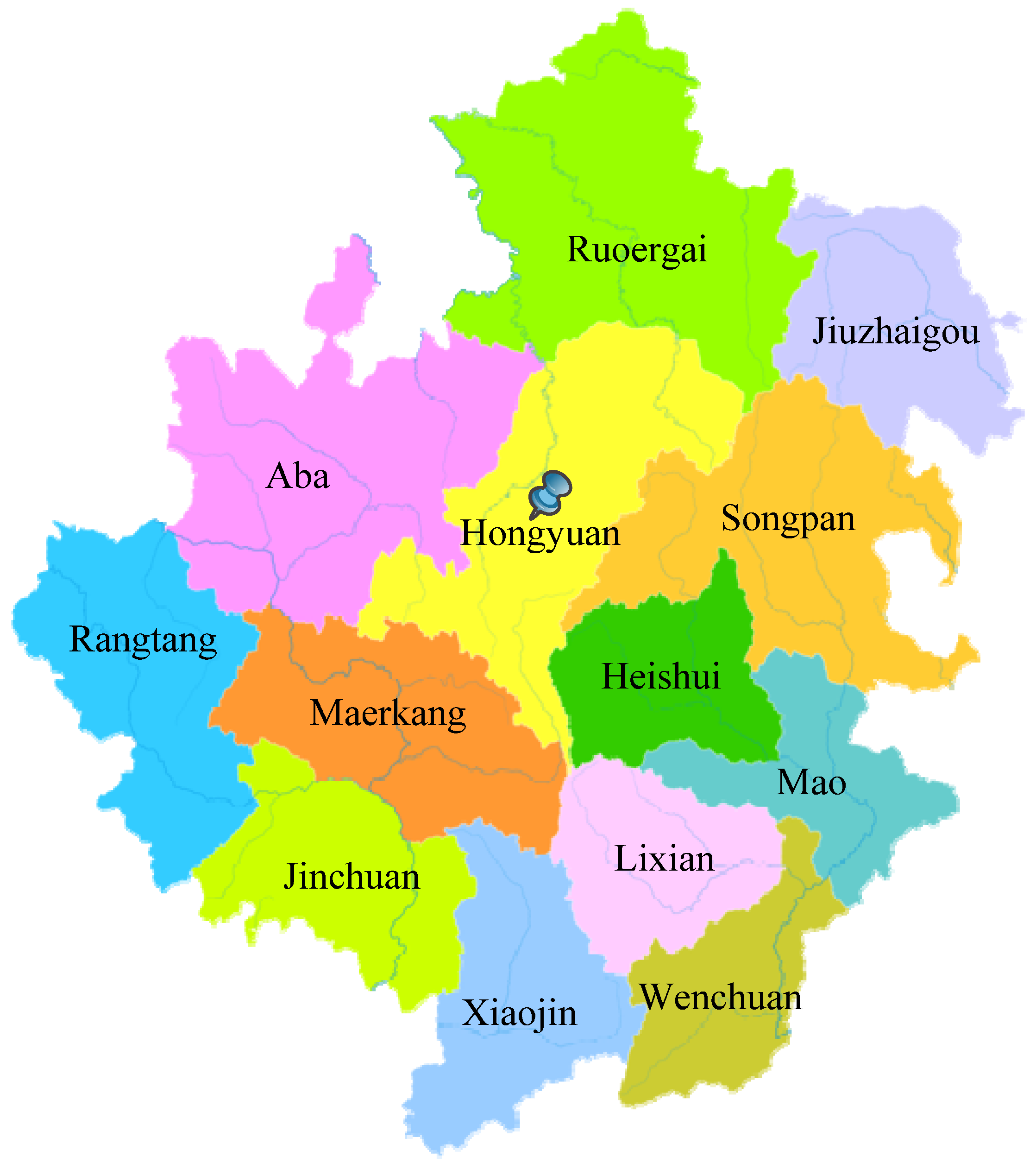

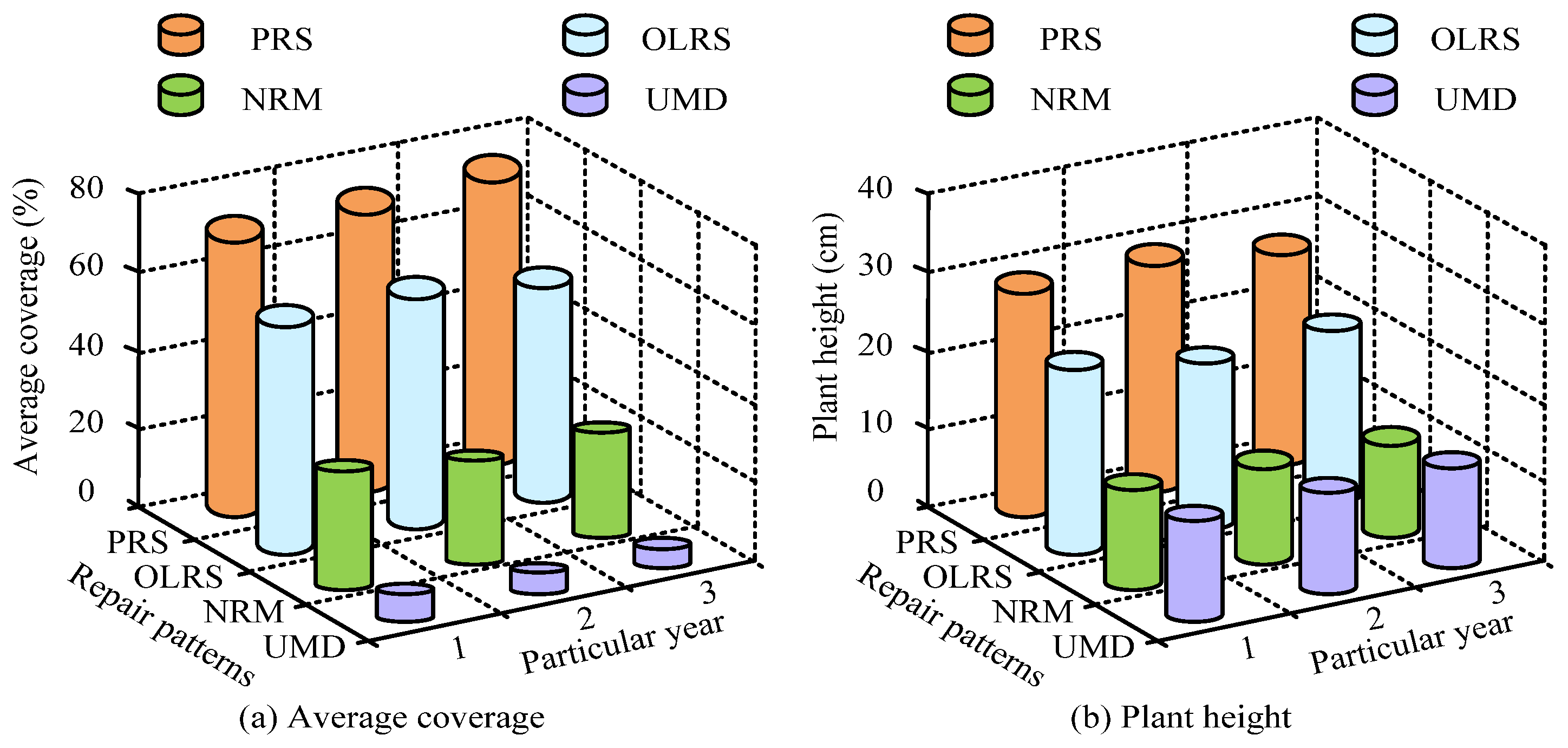

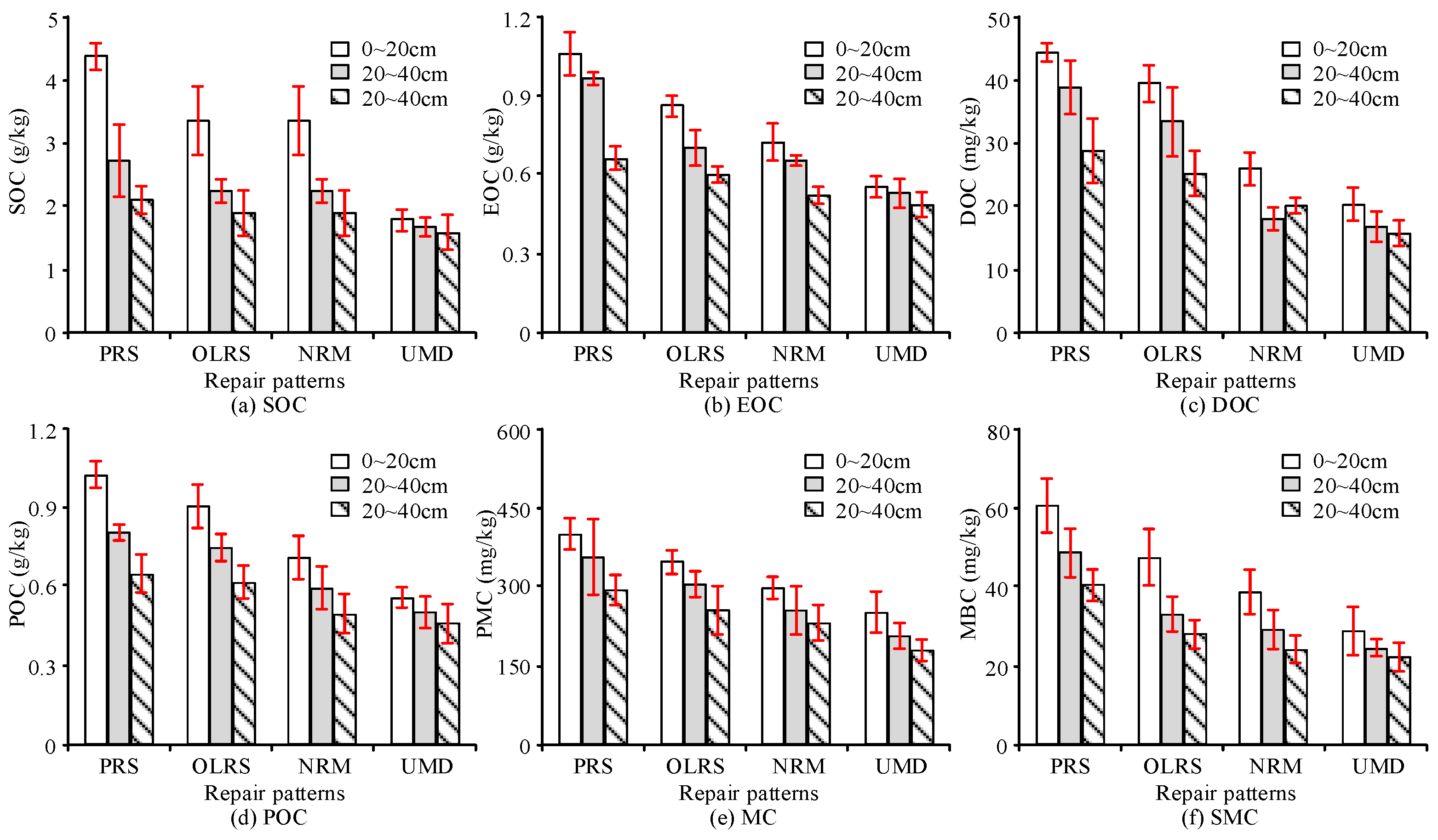
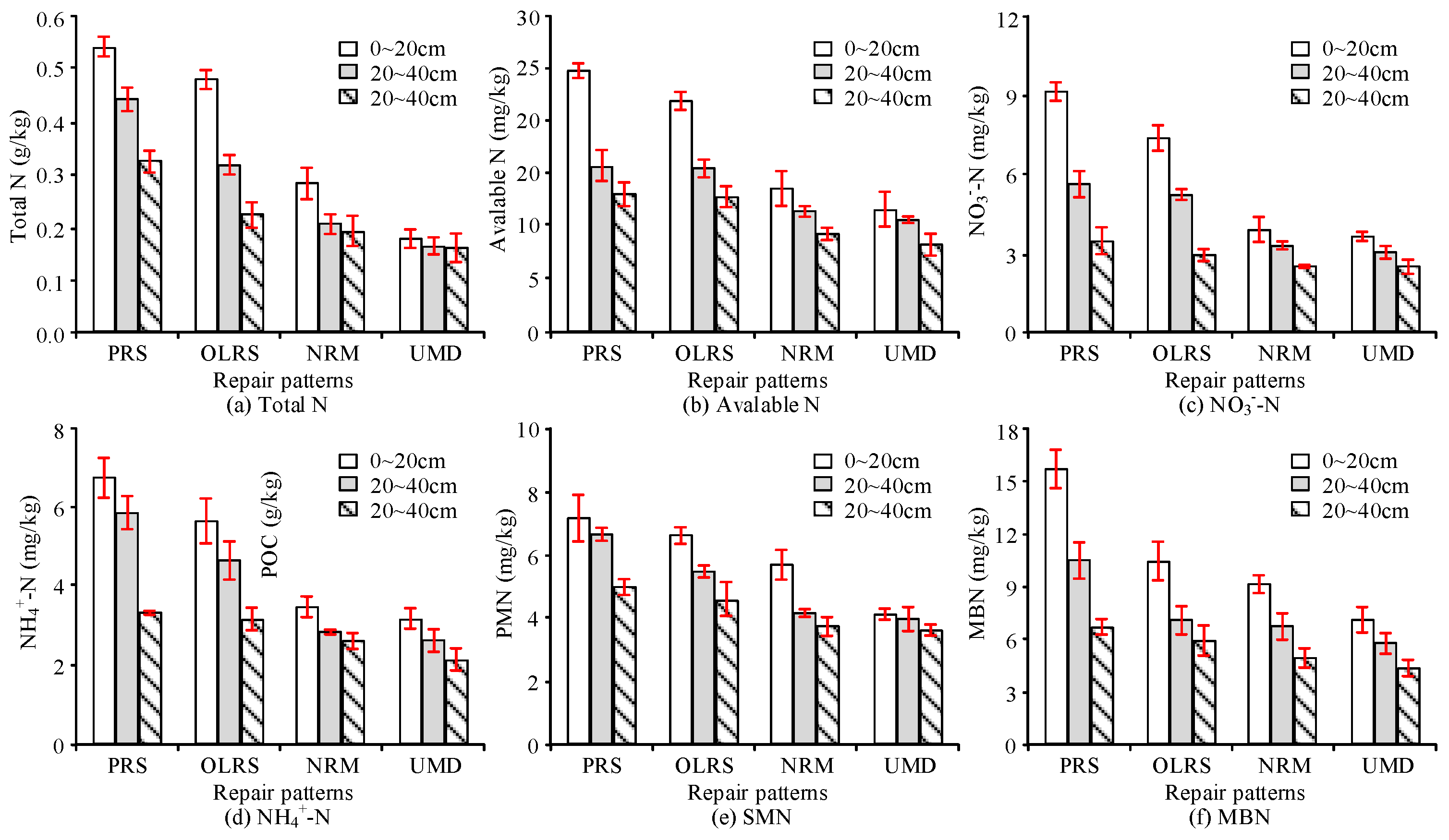
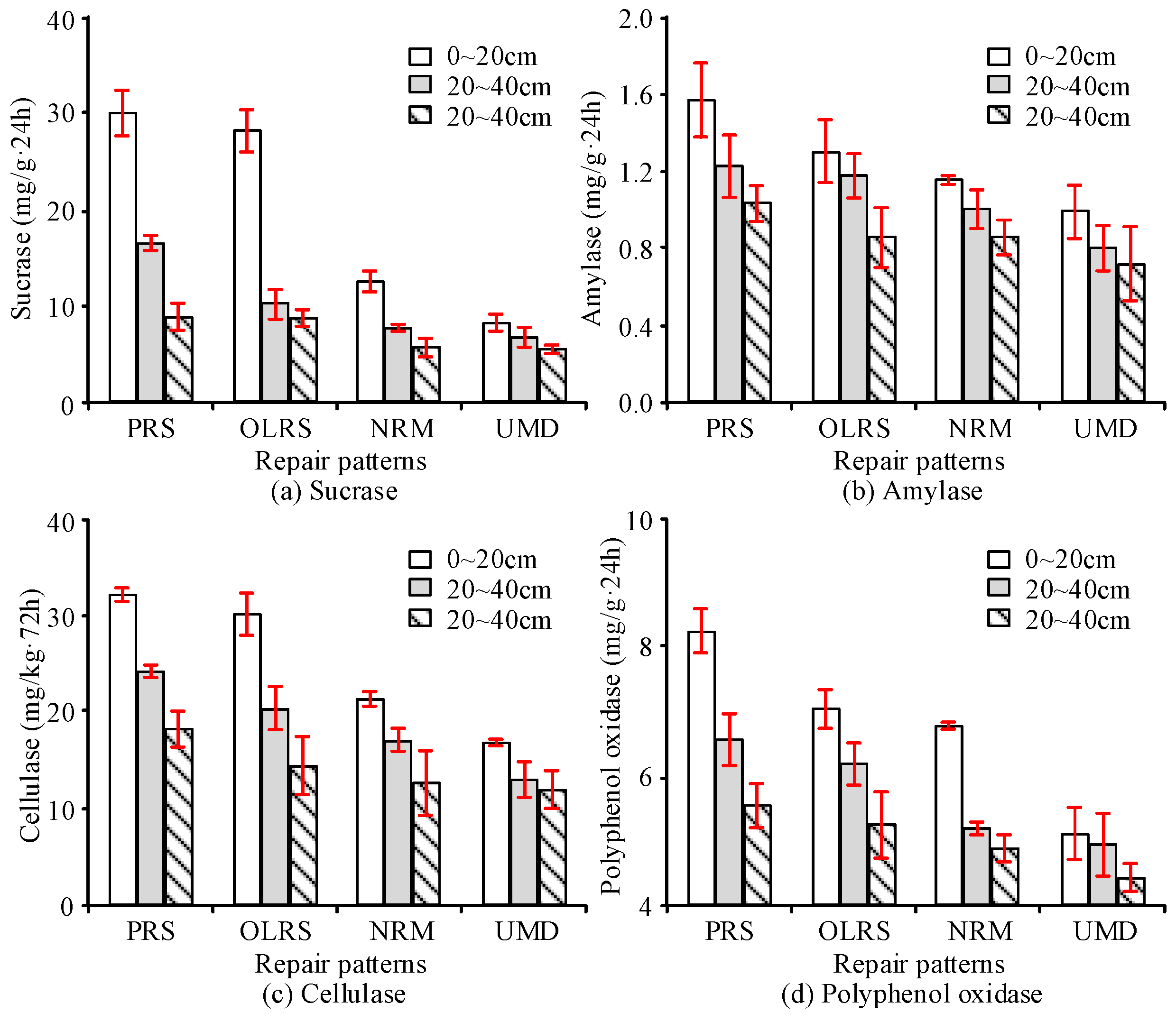

| Item | 0–20 cm | 20–40 cm | 40–60 cm |
|---|---|---|---|
| Water (%) | 2.68 ± 0.94 | 3.55 ± 1.30 | 4.42 ± 1.11 *# |
| Bulk density (g/cm3) | 1.47 ± 0.15 | 1.48 ± 0.08 | 1.48 ± 0.17 |
| TN (g/kg) | 0.129 ± 0.09 | 0.124 ± 0.07 | 0.117 ± 0.05 |
| AN (mg/kg) | 7.03 ± 1.44 | 4.80 ± 1.17 | 3.26 ± 1.20 * |
| AP (mg/kg) | 5.76 ± 1.05 | 4.43 ± 0.80 | 3.90 ± 0.71 * |
| AK (mg/kg) | 28.74 ± 4.82 | 17.99 ± 4.22 * | 15.10 ± 2.98 * |
| SOC (g/kg) | 1.72 ± 0.09 | 1.65 ± 0.13 | 1.55 ± 0.07 * |
| Pattern | Layer (cm) | Water (%) | Bulk Density (g/m3) | pH |
|---|---|---|---|---|
| PRS | 0–20 | 4.42 ± 0.44 | 1.38 ± 0.12 | 6.60 ± 0.22 |
| 20–40 | 4.93 ± 0.46 * | 1.39 ± 0.10 | 6.84 ± 0.13 | |
| 40–60 | 5.86 ± 0.58 * | 1.44 ± 0.11 | 7.15 ± 0.12 | |
| OLRS | 0–20 | 4.13 ± 0.32 | 1.41 ± 0.13 | 6.78 ± 0.28 |
| 20–40 | 4.53 ± 0.42 * | 1.42 ± 0.11 | 7.03 ± 0.24 | |
| 40–60 | 5.22 ± 0.52 *# | 1.45 ± 0.12 | 7.22 ± 0.22 | |
| NRM | 0–20 | 3.11 ± 0.53 ab | 1.42 ± 0.10 | 6.90 ± 0.24 |
| 20–40 | 3.85 ± 0.39 * | 1.44 ± 0.11 | 7.05 ± 0.22 | |
| 40–60 | 4.64 ± 0.33 *#a | 1.46 ± 0.09 | 7.33 ± 0.27 | |
| UMD | 0–20 | 2.32 ± 0.11 ab | 1.48 ± 0.09 | 7.14 ± 0.20 |
| 20–40 | 3.54 ± 0.22 *ab | 1.48 ± 0.08 | 6.88 ± 0.17 * | |
| 40–60 | 4.31 ± 0.14 *# | 1.46 ± 0.11 | 7.37 ± 0.22 # |
Disclaimer/Publisher’s Note: The statements, opinions and data contained in all publications are solely those of the individual author(s) and contributor(s) and not of MDPI and/or the editor(s). MDPI and/or the editor(s) disclaim responsibility for any injury to people or property resulting from any ideas, methods, instructions or products referred to in the content. |
© 2023 by the authors. Licensee MDPI, Basel, Switzerland. This article is an open access article distributed under the terms and conditions of the Creative Commons Attribution (CC BY) license (https://creativecommons.org/licenses/by/4.0/).
Share and Cite
Jiang, J.; Wang, Q.; Zhao, J.; Zhang, J.; Dong, B.; Huang, X. Construction and Application of Ecological Remediation Technology for Sandy Soils in Northwest China. Sustainability 2023, 15, 14730. https://doi.org/10.3390/su152014730
Jiang J, Wang Q, Zhao J, Zhang J, Dong B, Huang X. Construction and Application of Ecological Remediation Technology for Sandy Soils in Northwest China. Sustainability. 2023; 15(20):14730. https://doi.org/10.3390/su152014730
Chicago/Turabian StyleJiang, Jing, Qian Wang, Jinmei Zhao, Jun Zhang, Bo Dong, and Xin Huang. 2023. "Construction and Application of Ecological Remediation Technology for Sandy Soils in Northwest China" Sustainability 15, no. 20: 14730. https://doi.org/10.3390/su152014730
APA StyleJiang, J., Wang, Q., Zhao, J., Zhang, J., Dong, B., & Huang, X. (2023). Construction and Application of Ecological Remediation Technology for Sandy Soils in Northwest China. Sustainability, 15(20), 14730. https://doi.org/10.3390/su152014730







